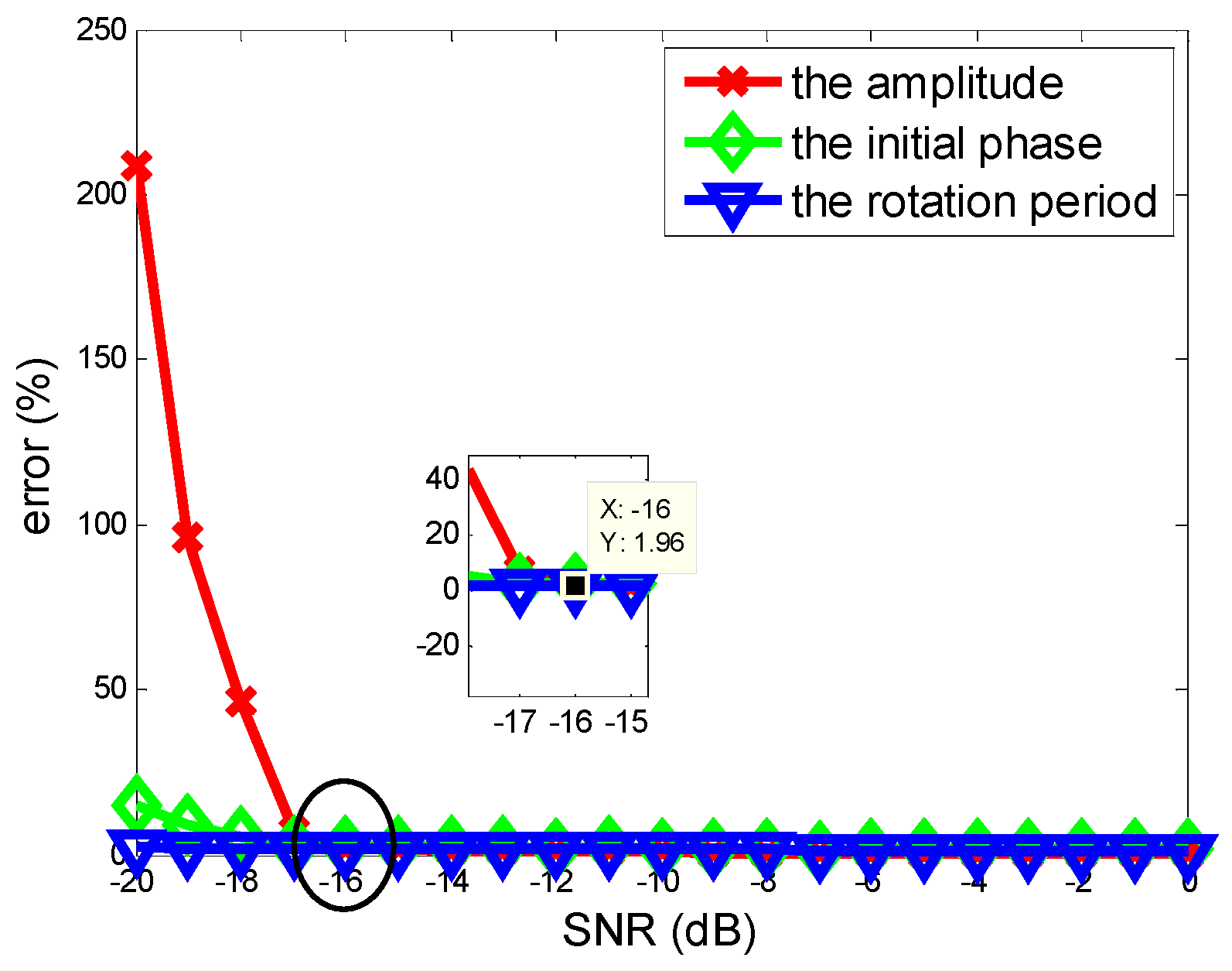Parameter Estimation of Micro-Motion Targets for High-Resolution-Range Radar Using Online Measured Reference
Abstract
:1. Introduction
2. Micro-Range Signature
3. Estimate Method
3.1. Calculation for MFCMRP
3.2. Parameters Estimation and Image Reconstruction
- According to the HRRPs by dechirping echo with online reference, the MFCMRP can be obtained through Equations (4) and (8).
- Performing WT on the MFCMRP can get the random item, the residual translational motion, compensating the contaminated HRRPs with the residual translational motion can get the rotational m-R signatures. Autocorrelation operation is a popular method to estimate the period in periodic function and is utilized for the rotational period estimation.
- Performing inverse radon transform on the compensated HRRPs would get the estimation of rotational parameters, including the amplitude and the phase of rotational motion.
4. Experiments
4.1. Experiment 1
4.2. Experiment 2
5. Conclusions
Author Contributions
Funding
Conflicts of Interest
Appendix A
References
- Chen, V.C.; Li, F.; Ho, S.S.; Wechsler, H. Micro-Doppler effect in radar: Phenomenon, model, and simulation study. IEEE Trans. Aerosp. Electron. Syst. 2006, 42, 2–21. [Google Scholar] [CrossRef]
- Saho, K.; Fujimoto, M.; Masugi, M.; Chou, L.S. Gait Classification of Young Adults, Elderly Non-Fallers, and Elderly Fallers Using Micro-Doppler Radar Signals: Simulation Study. IEEE Sens. J. 2017, 17, 2320–2321. [Google Scholar] [CrossRef]
- Singh, A.K.; Kim, Y.H. Automatic measurement of Blade Length and Rotation Rate of Drone Using W-Band Micro-Doppler Radar. IEEE Sens. J. 2018, 18, 1895–1902. [Google Scholar] [CrossRef]
- Yang, Q.; Deng, B.; Wang, H.Q.; Qing, Y.L. Parameter Estimation and Imaging Reconstruction of Rotating Targets with Vibrating Interference in the Terahertz Band. J. Infrared Millim. Terahertz Waves 2017, 38, 909–928. [Google Scholar] [CrossRef]
- Tran, H.T.; Heading, E.; Melino, R. OMP-based translational motion estimation for a rotating target by narrowband radar. IET Radar Sonar Navig. 2017, 11, 854–860. [Google Scholar] [CrossRef]
- Zhang, W.; Fu, Y.W.; Nie, L.; Zhao, G.H.; Yang, W.; Yang, J. Parameter estimation of micro-motion targets for high-range-resolution radar using high-order difference sequence. IET Signal Process 2018, 12, 1–11. [Google Scholar] [CrossRef]
- Zhang, W.; Li, K.; Jiang, W. Parameter estimation of radar targets with macro-motion and micro-motion based on circular Correlation Coefficients. IEEE Signal Process. Lett. 2015, 22, 633–637. [Google Scholar] [CrossRef]
- Zhou, Y.; Chen, Z.Y.; Zhang, L.R.; Xiao, J.G. Micro-doppler curves extraction and parameter estimation for cone-shaped target with occlusion effect. IEEE Sens. J. 2018, 18, 2892–2902. [Google Scholar] [CrossRef]
- Jung, J.H.; Kim, S.H.; Choi, I.; Kim, K.; Park, S.H. Efficient translational motion compensation for micro-doppler ectraction of ballistic missiles. Int. J Aeron. Space Sci. 2017, 18, 129–137. [Google Scholar] [CrossRef]
- Li, G.; Varshney, P.K. Micro-Doppler parameter estimation via parametric sparse representation and pruned orthogonal matching pursuit. IEEE J. Sel. Top. Appl. Earth Obs. Remote Sens. 2014, 7, 4937–4948. [Google Scholar] [CrossRef]
- Rao, W.; Li, G.; Wang, X.; Xia, X.G. Parametric sparse representation method for ISAR imaging of rotating targets. IEEE Trans. Aerosp. Electron. Syst. 2014, 50, 910–919. [Google Scholar] [CrossRef]
- Nguyen, N.H.; Dogancay, K.; Tran, H.T.; Berry, P. An image focusing method for sparsity-driven radar imaging of rotating targets. Sensors 2008, 18, 1840. [Google Scholar] [CrossRef] [PubMed]
- Stankovic, L.; Thayaparan, T.; Djurovic, L. Separation of target rigid body and micro-doppler effects in ISAR imaging. IEEE. Aerosp. Electron. Syst. 2006, 42, 101–110. [Google Scholar] [CrossRef]
- Donoho, D.L. De-noising by Soft-Thresholding. IEEE Trans. Inf. Theor. 2002, 41, 613–627. [Google Scholar] [CrossRef]
- Choi, H.; Jeong, J. Despecking images using a preprocessing filter and discrete wavelet transform-based noise reduction techniques. IEEE Sens. J. 2018, 18, 3131–3139. [Google Scholar] [CrossRef]






© 2018 by the authors. Licensee MDPI, Basel, Switzerland. This article is an open access article distributed under the terms and conditions of the Creative Commons Attribution (CC BY) license (http://creativecommons.org/licenses/by/4.0/).
Share and Cite
Xing, Y.; You, P.; Yong, S. Parameter Estimation of Micro-Motion Targets for High-Resolution-Range Radar Using Online Measured Reference. Sensors 2018, 18, 2773. https://doi.org/10.3390/s18092773
Xing Y, You P, Yong S. Parameter Estimation of Micro-Motion Targets for High-Resolution-Range Radar Using Online Measured Reference. Sensors. 2018; 18(9):2773. https://doi.org/10.3390/s18092773
Chicago/Turabian StyleXing, Yu, Peng You, and Shaowei Yong. 2018. "Parameter Estimation of Micro-Motion Targets for High-Resolution-Range Radar Using Online Measured Reference" Sensors 18, no. 9: 2773. https://doi.org/10.3390/s18092773




